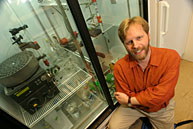Turning drug design on its head
Turning drug design on its head McGill University
User Tools (skip):
Turning drug design on its head
It seems unlikely -- tiny microbes outsmarting the latest and most sophisticated research efforts -- but drug-resistant bacteria are on the rise. Once destroyed by drugs, microbes have turned the tables and developed mechanisms to withstand the most brutal clinical assaults without even batting an eye. As a consequence, we are left defenseless against the infections we once controlled. More than ever, we need researchers to find original ways to combat these ever-mutating microbes.
 Professor of microbiology and immunology Albert Berghuis
Professor of microbiology and immunology Albert BerghuisPhoto: Owen Egan |
|
Albert Berghuis, Canada Research Chair in Structural Biology professor of microbiology and immunology, fights disease with a novel approach to designing drugs. A bacteria's essential proteins need to be identified so that drugs can be developed to target them. The key to Berghuis' work is to determine the structure of a bacteria's essential protein. Then drugs can be developed to target, or block, these proteins that will prevent them from functioning normally. As a consequence, the bacteria will die. Known as structure-based drug design, Berghuis' work differs radically from traditional drug development.
Drug development in the past was not disease specific. Rather, once scientists found a compound they found a disease to go with it. (Viagra is a classic example of this approach -- originally intended to treat hypertension, it revealed significantly more interesting side effects.) This classic strategy is random and time-consuming. Berghuis' structure-based drug-design is the reverse of this approach by going from bacteria to drug rather than from drug to bacteria.
Berghuis studies essential proteins with x-ray crystallography that incorporates elements of physics, biochemistry and computer science, allowing him to draw on his multidisciplinary background in chemistry and biology. Once the structure is known, drugs are designed to fit into the protein. It is like figuring out the shape of a lock to build a key that will fit.
Bacteria are smart. "Nature really has a way of figuring things out," muses Berghuis. Bacteria become resistant to drugs by synthesizing a duplicate copy of the target-protein. These decoys divert the drug away from its real target, leaving the original protein intact. Many serious infections use this mechanism, such as VRE (Vancomycin-Resistant Enterococci) and MRSA (Methicillin Resistant Staphylococ-cus). It is essential to target these mechanisms because these infections are becoming more and more prevalent. Berghuis says, "While we used to think that these sorts of infections targeted communities with compromised immune systems, such as hospitals, old-age homes, and the developing world, they are now showing up in otherwise healthy people."
Berghuis' work is one way to combat drug-resistant microbes. However, while drug development is essential, prevention is equally important. Everyone, from the farmer who limits the antibiotics in cattle feed to the average barbequer, has a role in fighting drug-resistant bacteria. Berghuis gives some practical advice to help stop microbial spread. "When you get a bacterial infection, make sure that you use the appropriate antibiotic therapy and fully complete that therapy -- don't stop the medication when you feel better, but continue it for the prescribed length of time. In addition, don't use antibiotics to treat a viral infection; doing so is both useless and promotes antibiotic resistance."
Optimistic by nature, Berghuis quotes from the film Apollo 13 when asked his prediction for the future: "Failure is not an option." Although there is no ultimate solution and we may never overcome the resistance mechanism in microbes, structure-based drug design looks like a worthy challenger to superbugs. Mutating microbes beware!
McGill's SPARK program (Students Promoting Awareness of Research Knowledge) is funded by NSERC and run by the Faculty of Education, VP Research Office, and the University Relations Office.

